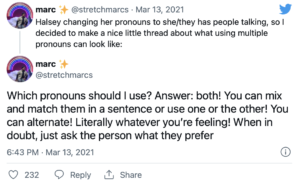As marketers, it is our responsibility to address people respectfully and nothing is more important than simply using the correct pronouns. We’re all familiar with she/her and he/him pronouns, but there’s a third set of pronouns that we need to become more familiar with, and that’s singular they/them pronouns.
Why Would Someone Use They/Them Pronouns?

To answer this question, we’re going to need to do a crash course in gender theory. In our society, we have a gender binary: a system of gender classification in which all people are categorized as being either male or female. This is a very traditional way of looking at gender, where you’re either one gender or the other and are expected to follow the societal standards and expectations of that gender.
But some people don’t feel like they identify with the rules of the gender binary, or the gender assigned to them at birth. For some people, that may mean transitioning to the opposite gender as that’s what they feel comfortable with. But for others, they may not identify as either male or female. Some may feel very comfortable in the middle as androgynous and gender-fluid individuals who don’t feel specifically tied to one gender. Other folks don’t identify in the gender binary at all and feel they are completely genderless, taking on a genderless pronoun.
They/Them Pronouns Are Already Ungendered Words
Because these folks don’t identify with the two genders in the binary, and we haven’t created a new language for other genders, many nonbinary individuals will take on they/them pronouns because they’re already ungendered words.
“Using someone’s correct personal pronouns is a way to respect them and create an inclusive environment, just as using a person’s name can be a way to respect them. Just as it can be offensive or even harassing to make up a nickname for someone and call them that nickname against their will, it can be offensive or harassing to guess at someone’s pronouns and refer to them using those pronouns if that is not how that person wants to be known.”
Examples of They/Them Pronouns Used in the Singular

When you find a lost wallet on the ground you don’t go looking for him or her, you go looking for them so that you can return their wallet because they need it back.
It has been very common in academia over the last 40 years to write “he or she” when writing about someone whose gender is unknown. But that is extremely clunky and redundant when we’ve already had language for when we don’t know someone’s gender.
If you’re still unsure about how best to use singular they/them pronouns, here are some more examples of them in action.
- “They were telling me about their day.”
- “They’re going to the beach today with their friends.”
- “I had lunch with them and their mom.”
The Singular “They” Is Grammatically Correct!
The biggest complaint that grammatically minded folk have is that “they” should be plural. But we’re about to pop that myth. In fact, “you” only became singular in the 17th century — before that, it was always plural! Famous authors throughout history, from Shakespeare to Jane Austen, have used the singular “they.”
Jane Austen actually uses they in the singular 75 times in Pride and Prejudice (1813), according to The Guardian. As early as 1395, Geoffrey Chaucer wrote, “And whoso fyndeth hym out of swich blame, They wol come up…”
“This is an English problem; the ‘all languages are this way, it’s just the way of the world’ argument is a convenient one, but not true. While the push to use ‘they’ as a genderless pronoun is new for English, it is rather old hat in other languages. While English was picking and choosing its vocabulary from Latin and German, so many other languages – Turkish, Hungarian, Finnish, Persian – are entirely genderless.”
The Guardian, ‘They’: the singular pronoun that could solve sexism in English
As Elizabeth Bennet declares to Mr. Darcy, “To be sure, you knew no actual good of me — but nobody thinks of that when they fall in love.”
Since 2015, the Washington Post has used “they” as a singular pronoun. Even AP Stylebook approved “they” in this usage in 2017 “when alternative wording is overly awkward or clumsy.” In 2019, Merriam-Webster added a definition to “they” for use by a singular person and even made “they” the Word of the Year in 2019 to celebrate.
“Alternating he and she is silly,” argues Washington Post copy editor Bill Walsh in a Time article, “as are he/she, (s)he, and attempts at made-up pronouns.”
If they are doing it, you can, too!
She/They, He/They, Xe/Xem, Ze/Zir, ETC.!
It may come as a surprise, but a cursory Google of “How many genders are there?” can garner as many as 58 or even 72 genders! We’ve come a long way from the binary, baby.
On top of they/them pronouns, here are some of the other most common pronouns on the nonbinary continuum:
She/They and He/They
Which one is it — She, or they? He, or they? The answer: both!
Someone who uses she/they pronouns may identify as both being a woman and nonbinary. Or, they could be genderfluid, genderqueer, bigender, or another identity. (For more, check out A Guide to Genderqueer, Non-Binary, and Genderfluid Identity from Psychology Today.)
These folks are often okay with either pronoun, and it’s usually understood that they would like you to use a mix of both “she” and “they.” So, if someone identifies as he/they, mix up using “he” and “they” to refer to that person.
For example, American singer/songwriter Halsey uses she/they pronouns. As this Tweet says, when in doubt, ask them what they prefer:
Xe, Xyr (Xem), Xyrs, Xyrself (Xemself)
This is another set of gender-neutral pronouns that some prefer. Pronounced “zee/zem/zeer.”
This handy video can help:
These are just some examples of gender-neutral pronouns that are among the most common. As always, it’s best to refer to people by the pronouns they identify with.
Being Gender-Inclusive in Our Language

Whether we are aware of it or not, we have a lot of gender incorporated in our language and the words we use. Whether you’re addressing a group by saying “hey, guys” or even “ladies and gentlemen,” you’re including one or two genders, which will make others feel left out or misgendered.
The folks in the south are really good at inclusivity in language whether they know it or not. “Y’all” is a great way of addressing a group of people without including gender in what you say. Though this phrase isn’t great in professional language for your marketing materials, it can be very helpful and inclusive when talking to students and faculty. There are many great ways of addressing people that are gender-inclusive and even fun. Below we’ve listed some of our favorites in order of professionalism:
- “Hello, everyone.”
- “Good morning, folks!”
- “Hi, y’all!”
- “Welcome, friends!”
- “Hey, team!”
- “Hello, all you guys, gals, and nonbinary pals!”
- “What is up, party people?”
- “Howdy, partner!”
- “Ahoy, matey!”
- “Hey, besties!”
- “Good morning star shine, the Earth says hello!”
- “Privet, comrades!”
Language and word choice are critical in conveying your message to people, so let’s start addressing people respectfully and inclusively.
Would you like to keep on reading? Below are similar blogs you might enjoy:
- 3 Ways to Support LGBTQ+ Students on Your College Campus
- Writing and Marketing to Latino and Hispanic Students
- What are Él, Ella, and Elle Pronouns? And What Does “Latinx” Really Mean? [Hispanic Heritage Month Roundup]




